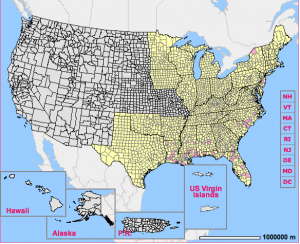
The death rate is 75%–100% of animals infected with Eastern Equine Encephalitis.
Vaccinations are available and are usually part of a 3, 4, 5 or 6 way vaccination to protect against a variety of encephalitis and more.
Horses that have never been vaccinated will need two doses, two to four weeks apart, and the vaccine will take at least two weeks to build up enough antibodies to protect them. A booster should be given at least annually and takes about four days to be effective. Vaccines will not protect horses that have already been infected when they receive the injections.
A total of 97 cases have been reported in Alabama, Florida, Georgia, Louisana, Missippi, New Jersey, New York, North Carolina and South Carolina. And two were reported August 22nd in Wisconsin. The town of Hamilton in Massachussettes is spraying to help prevent the disease.
Review the Gov’t Map for the latest data:
http://diseasemaps.usgs.gov/eee_us_veterinary.html
Mosquitoes carry the disease from birds to horses. It affects the central nervous system and is transmitted to horses by infected mosquitoes. The course of EEE generally is short, with death occurring two to three days after onset of symptoms despite intensive care. Horses that survive might have long-lasting impairments and neurologic problems. Clinical signs of EEE include moderate to high fever, depression, lack of appetite, cranial nerve deficits (facial paralysis, tongue weakness, difficulty swallowing), behavioral changes (aggression, self-mutilation, or drowsiness), gait abnormalities, or severe central nervous system signs, such as head-pressing, circling, blindness, and seizures.





















